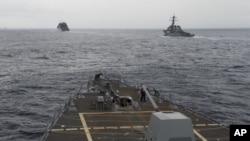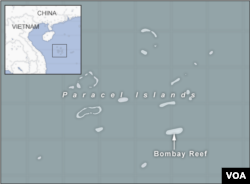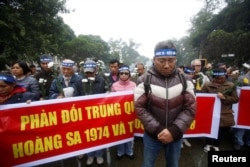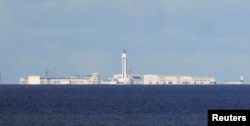Two American B-52 bombers flew over the South China Sea on a training mission Wednesday for the second time in 10 days, acts that Beijing considers provocative. Chinese officials resent any challenge to their hold over hundreds of the sea’s tiny islets, which other countries claim, too.
But China appears, at least for now, to be done adding positions in the sea that’s claimed in whole or in part by five other governments, maritime scholars agree. They say a seven-year effort to reclaim land for building on once uninhabitable atolls and reefs paused indefinitely two years ago because Beijing had reached the level of control it wanted over the waterway.
“The Chinese basically feel that they have finished what they called the first stage of land reclamation in the South China Sea,” said Yun Sun, East Asia Program senior associate with the Stimson Center think tank in Washington.
Indefinite pause
Island building that started around 2010 led to the construction of aircraft hangars, radar systems and facilities to support fishing and oil exploration. Civilian populations live on a few islets. China controls the whole 130-island Paracel chain and seven major features in the Spratly archipelago.
Chinese contractors created 3,200 acres of reclaimed land on the sea’s reefs and atolls to help develop them, according to a Pentagon estimate in 2016.
“If the end goal is de facto control of the waterways and air space, then perhaps the number of features that China currently occupies are enough to achieve that end goal,” said Jonathan Spangler, director of the South China Sea Think Tank in Taipei.
Brunei, Malaysia, the Philippines, Taiwan and Vietnam claim all or parts of the sea, which stretches from Hong Kong to the island of Borneo. Those governments prize the 3.5 million-square-kilometer waterway for its fisheries, shipping lanes and energy reserves under the seabed.
The other countries, all militarily weaker, resented China’s landfill work and follow-up militarization, especially when projects overlapped their own exclusive maritime economic zones. Their opposition has prompted the U.S. government to periodically send naval ships and aircraft through the area. Washington does not have a territorial claim but says the sea should be open to everyone.
China’s most recent significant dredging or landfill work took place on two Paracel islands in early to mid-2017, said Gregory Poling, director of the Asia Maritime Transparency Initiative under Washington-based think tank Center for Strategic and International Studies.
Most larger-scale building had wrapped up in 2015, Poling said.
Political will
China might restart reclamation or take over more islands after settling the year-old Sino-U.S. trade dispute, Sun said. Chinese consider trade talks a “priority for now,” she said, and don’t want to take action that would anger Washington. While trade talks are going on, she said, China might just strengthen existing maritime claims.
“The first stage is completed, so I think it’s more a question of political will to move forward with reclamation at this point,” she said.
Beijing will avoid taking over more islets controlled by other countries, Sun added, because it wants to strengthen relations with Asian governments as a counter to U.S. influence in the sea.
The Association of Southeast Asian Nations, which includes states that oppose Chinese maritime sovereignty claims, is talking with China now through 2021 about a code of conduct that would head off mishaps between ships.
China hasn’t occupied any new features since 1994, though it took effective control of Scarborough Shoal from the Philippines after a tense standoff in 2012, setting off a four-year political spat. Since 2016, China has offered aid and investment to the Philippines, helping to ease friction.
China probably won’t “proactively occupy new features” unless it feels pushed by a foreign government, Spangler said. Chinese officials cite historic documents to back their claim to about 90 percent of the sea.
The government is now in a phase of “deployment of assets” to the islands it holds, Poling said.
“I think there is a false assumption that not much is happening in the South China Sea, because there aren’t many clashes or incidents on the same scale, but China is continuing to fill in infrastructure on the islands at a fair clip and it’s already got the ability I think to use those islands,” said Euan Graham, executive director with La Trobe Asia, a unit of La Trobe University in Australia.
“They have all the infrastructure in terms of fuel, hangar space for combat aircraft,” Graham said.














